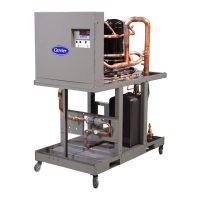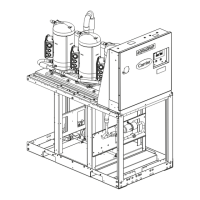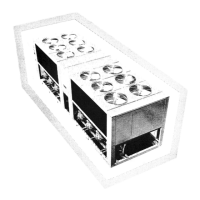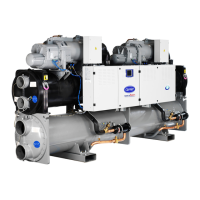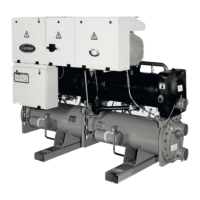Do you have a question about the Carrier 30MP and is the answer not in the manual?
Explains the purpose and function of the 30MP Multi-chiller application for controlling multiple chillers.
Details the technical specifications of the 30MP Multi-chiller controller, including power, ports, inputs, and outputs.
Provides critical warnings about electrical safety, handling the controller, and preventing damage during installation.
Instructions for physically mounting the controller into an enclosed panel, including handling precautions.
Step-by-step guide on connecting the controller to a power source, including voltage verification.
Procedure for assigning a unique network address to the controller using rotary switches.
Specifies cable requirements and connection methods for BACnet network segments.
Lists available inputs and outputs, their types, terminal connections, and functions.
Details maximum lengths, wire gauges, and shielding requirements for different input signal types.
Explains the characteristics and considerations for wiring binary and analog outputs.
Step-by-step instructions for connecting various input and output signals to the controller terminals.
Provides wiring specifications, including cable type and maximum length, for connecting sensors.
Details how to wire the required leaving chilled water header temperature sensor.
Instructions for wiring the optional outdoor air temperature sensor for setpoint reset.
Instructions for wiring the optional relative humidity sensor for humidity control overrides.
Guides the connection of a single Equipment Touch device to the controller's Rnet port.
Explains the symbols and abbreviations used in the wiring diagrams.
Presents the consolidated wiring diagram for the 30MP Multi-chiller system.
Steps to address and configure the chiller system before starting the controller, supporting up to 8 chillers.
Instructions for staging and addressing chillers based on model size for optimal control.
Guidance on configuring essential points and properties for controller operation, referencing Appendix C.
Describes how the 30MP Multi-chiller sequences chillers to maintain the desired water temperature setpoint.
Details the different methods for setting occupancy schedules for the unit.
Explains the three stages of demand limiting and how it affects the operating setpoint.
Describes how outdoor air temperature can be used to adjust the cooling water temperature setpoint.
Explains how relative humidity can reduce the OA reset to improve humidity control.
Discusses various methods for rotating chillers in equal-sized systems.
Details the use of an analog input for an external setpoint, including range variations.
Explains how the 30MP Multi-chiller exchanges data with individual chillers via linkage.
Describes the status indicated by the controller's Power, Rx, Tx, Run, and Error LEDs.
Instructions on how to replace the controller's backup battery, noting data preservation.
Outlines the FCC and CE compliance statements for the device.
States compliance with ASHRAE Standard 135 for BACnet.
A detailed list of points and their associated wiring information for the 30MP Multi-chiller.
Explains how to configure DAB to allow data reception from other Open controllers within an i-Vu® system.
Lists and describes various status points available for monitoring the chiller plant's operation.
Details settings for enabling/disabling cooling, lockout temperature, and setpoint resets.
Configuration options for how the controller behaves after a power loss.
Options for calibrating temperature and humidity sensors to match standards.
Describes the selectable methods for rotating lead chillers in equal-sized systems.
Defines the target chilled water temperature for the plant, with clamping to prevent freezing.
Configures setpoints for condenser water temperature at minimum, partial, and full load.
Sets limits and hysteresis for alarms related to leaving and entering water temperatures.
Configures alarms for high relative humidity and outdoor air temperature deviations.
Defines whether the controller uses Leaving or Entering water temperature for control.
Sets the minimum number of chillers that must be running simultaneously.
Defines time delays for adding or removing compressor stages to manage capacity.
Lists parameters for the Proportional, Integral, Derivative, and Bias settings of control loops.
Enables or disables alarms for linkage failures with individual chillers.
Specifies the equipment type and the primary control point for the system.
Indicates chiller size comparison and the status of external demand limit input.
Defines the source (local, network, linkage) for leaving and entering water temperatures.
Specifies the origin of the control setpoint value.
Defines the source for outdoor air temperature and relative humidity readings.
Configures how the controller determines and uses occupancy status.
Lists alarms for equipment status, power failures, and temperature deviations.
Monitors alarms related to system status, linkage failures, and sensor availability.
Details configuration for the linkage provider of Chiller #1, including network number and address.
Lists I/O points and their parameters, with warnings against changing critical settings.
Guides for navigating the System Touch interface for setup and configuration.
Instructions on defining an address range to optimize the discovery of network devices.
Describes the display and details of various screens on the 30MP Multi-chiller Equipment Touch interface.
Explains how to configure the visibility of values on different screens based on password level.
Details setting the Collector Network Number and MS/TP address for linkage.
Configuration options for control point and minimum number of chillers to run.
Lists important changes made to the document, including dates and descriptions.
